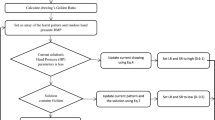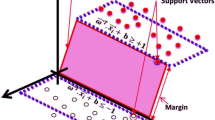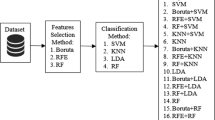Abstract
The least squares support vector machine (LSSVM) is a useful binary classifier, but its performance is limited due to the lack of sparseness. The density-dependent quantized LSSVM (DSM) with quantized input data can increase the sparseness to effectively accomplish binary classification. However, the DSM cannot be directly used in multi-classification applications for most practical data-classification problems. We propose a novel multi-classifier based on a density-dependent quantized binary tree LSSVM (DBSM) and the logistic global whale optimization algorithm (LWA) to improve multi-classification accuracy and computational efficiency. The DBSM consists of multiple DSM classifiers, which hierarchically divide data according to a modified binary tree architecture. The tree architecture is constructed quickly and correctly with the quantized data instead of the original input data. An appropriate initial population of DBSM parameters is generated by using a logistic map and an improved opposition-based learning strategy. Then, the DBSM parameters are optimized by the whale optimization algorithm integrated with the gbest-guided artificial bee colony algorithm. According to the experimental results, the DBSM solves multi-classification problems faster than the one-versus-one based support vector machine (OVO-SVM) and the one-versus-all based LSSVM without sacrificing accuracy. The LWA precisely finds the optimal DBSM parameters without a heavy computational burden, in contrast to recent optimization algorithms. The proposed classifier achieves a 3.39% higher accuracy and consumes 52.83% less time than the genetic algorithm-based OVO-SVM. These results prove that the LWA-DBSM can complete multi-class classification tasks precisely and quickly.







Similar content being viewed by others
References
Wu XD, Zhu XQ, Wu GQ, Ding W (2014) Data mining with big data. IEEE Trans Knowl Data Eng 26(1):97–107. https://doi.org/10.1109/tkde.2013.109
Wang JX, Tan DP, Cao B, Fan J, Deep S (2020) Independent path-based process recommendation algorithm for improving biomedical process modeling. Electronics Letter 2:1–13. https://doi.org/10.1049/el.2019.3978
Suykens JAK, Vandewalle J (1999) Least squares support vector machine classifiers. Neural Process Letters 9(3):293–300. https://doi.org/10.1023/a:1018628609742
Tang JJ, Liu F, Zou YJ, Zhang WB, Wang YH (2017) An improved fuzzy neural network for traffic speed prediction considering periodic characteristic. IEEE Trans Intell Transpo Sys 18(9):2340–2350. https://doi.org/10.1109/tits.2016.2643005
Ticay-Rivas JR, del Pozo-Banos M, Eberhard WG, Alonso JB, Travieso CM (2013) Spider specie identification and verification based on pattern recognition of it cobweb. Expert Syst Appl 40 (10):4213–4225. https://doi.org/10.1016/j.eswa.2013.01.024
Bui DT, Tuan TA, Hoang ND, Thanh NQ, Nguyen DB, Liem NV, Pradhan B (2017) Spatial prediction of rainfall-induced landslides for the Lao Cai area (Vietnam) using a hybrid intelligent approach of least squares support vector machines inference model and artificial bee colony optimization. Landslides 14 (2):447–458. https://doi.org/10.1007/s10346-016-0711-9
Deng W, Yao R, Zhao HM, Yang XH, Li GY (2019) A novel intelligent diagnosis method using optimal LS-SVM with improved PSO algorithm. Soft Comput 23(7):2445–2462. https://doi.org/10.1007/s00500-017-2940-9
Li CB, Li SK, Liu YQ (2016) A least squares support vector machine model optimized by moth-flame optimization algorithm for annual power load forecasting. Appl Intell 45(4):1166–1178. https://doi.org/10.1007/s10489-016-0810-2
Oliveira SAF, Gomes JPP, Neto ARR (2018) Sparse least-squares support vector machines via accelerated segmented test: A dual approach. Neurocomputing 321:308–320. https://doi.org/10.1016/j.neucom.2018.08.081
Mall R, Suykens JAK (2015) Very sparse LSSVM reductions for large-scale data. IEEE Trans Neural Netw Learn Syst 26(5):1086–1097. https://doi.org/10.1109/tnnls.2014.2333879
Karsmakers P, Pelckmans K, De Brabanter K, Van Hamme H, Suykens JAK (2011) Sparse conjugate directions pursuit with application to fixed-size kernel models. Mach Learn 85(1-2):109–148. https://doi.org/10.1007/s10994-011-5253-8
Zhou SS (2016) Sparse LSSVM in Primal Using Cholesky Factorization for Large-Scale Problems. IEEE Trans Neural Netw Learn Syst 27(4):783–795. https://doi.org/10.1109/tnnls.2015.2424684
Silva DA, Silva JP, Neto ARR (2015) Novel approaches using evolutionary computation for sparse least square support vector machines. Neurocomputing 168:908–916. https://doi.org/10.1016/j.neucom.2015.05.034
Nan SY, Sun L, Chen BD, Lin ZP, Toh KA (2017) Density-dependent quantized least squares support vector machine for large data sets. IEEE Trans Neural Netw Learn Syst 28(1):94–106. https://doi.org/10.1109/tnnls.2015.2504382
Deng F, Guo S, Zhou R, Chen J (2017) Sensor multifault diagnosis with improved support vector machines. IEEE Trans Autom Sci Eng 14(2):1053–1063. https://doi.org/10.1109/tase.2015.2487523
Hamedi M, Salleh SH, Noor AM (2015) Facial neuromuscular signal classification by means of least square support vector machine for MuCI. Appl Soft Comput 30:83–93. https://doi.org/10.1016/j.asoc.2015.01.034
Zhang XK, Ding SF, Sun TF (2016) Multi-class LSTMSVM based on optimal directed acyclic graph and shuffled frog leaping algorithm. Int J Mach Learn Cybern 7 (2):241–251. https://doi.org/10.1007/s13042-015-0435-5
Khemchandani R, Sharma S (2016) Robust least squares twin support vector machine for human activity recognition. Appl Soft Comput 47:33–46. https://doi.org/10.1016/j.asoc.2016.05.025
Tomar D, Agarwal S (2015) A comparison on multi-class classification methods based on least squares twin support vector machine. Knowl.-Based Syst 81:131–147. https://doi.org/10.1016/j.knosys.2015.02.009
Cevikalp H, Elmas M, Ozkan S (2018) Large-scale image retrieval using transductive support vector machines. Comput Vis Image Underst 173:2–12. https://doi.org/10.1016/j.cviu.2017.07.004
Lee Y, Lee J (2015) Binary tree optimization using genetic algorithm for multiclass support vector machine. Expert Syst Appl 42(8):3843–3851. https://doi.org/10.1016/j.eswa.2015.01.022
Bogawar PS, Bhoyar KK (2018) An improved multiclass support vector machine classifier using reduced hyper-plane with skewed binary tree. Appl Intell 48(11):4382–4391. https://doi.org/10.1007/s10489-018-1218-y
Yu LA, Dai W, Tang L, Wu JQ (2016) A hybrid grid-GA-based LSSVR learning paradigm for crude oil price forecasting. Neural Computing & Applications 27(8):2193–2215. https://doi.org/10.1007/s00521-015-1999-4
Ghamisi P, Benediktsson JA (2015) Feature Selection Based on Hybridization of Genetic Algorithm and Particle Swarm Optimization. IEEE Geoscience And Remote Sensing Letters 12(2):309–313. https://doi.org/10.1109/lgrs.2014.2337320
Pahasa J, Ngamroo I (2011) Least square support vector machine for power system stabilizer design using wide area phasor measurements. Int J Innov Comp Inf Control 7(7B):4487–4501
Yuan XH, Chen C, Yuan YB, Huang YH, Tan QX (2015) Short-term wind power prediction based on LSSVM-GSA model. Energy Conversion and Management 101:393–401. https://doi.org/10.1016/j.enconman.2015.05.065
Mirjalili S, Lewis A (2016) The whale optimization algorithm. Adv Eng Softw 95:51–67. https://doi.org/10.1016/j.advengsoft.2016.01.008
Sun WZ, Wang JS (2017) Elman neural network soft-sensor model of conversion velocity in polymerization process optimized by Chaos Whale optimization algorithm. IEEE Access 5:13062–13076. https://doi.org/10.1109/access.2017.2723610
Yan ZH, Sha JX, Liu B, Tian W, Lu JP (2018) An ameliorative whale optimization algorithm for multi-objective optimal allocation of water resources in Handan, China. Water 10(1):29. 10.3390/w10010087
Abd Elaziz M, Oliva D (2018) Parameter estimation of solar cells diode models by an improved opposition-based whale optimization algorithm. Energy Conversion and Management 171:1843–1859. https://doi.org/10.1016/j.enconman.2018.05.062
Abdel-Basset M, Manogaran G, El-Shahat D, Mirjalili S (2018) A hybrid whale optimization algorithm based on local search strategy for the permutation flow shop scheduling problem. Futur Gener Comp Syst 85:129–145. https://doi.org/10.1016/j.future.2018.03.020
Krishna JV, Naidu GA, Upadhayaya N (2018) A Lion-Whale optimization-based migration of virtual machines for data centers in cloud computing. Int J Commun Syst 31(8):18. https://doi.org/10.1002/dac.3539
Zhu GP, Kwong S (2010) Gbest-guided artificial bee colony algorithm for numerical function optimization. Appl Math Comput 217(7):3166–3173. https://doi.org/10.1016/j.amc.2010.08.049
Williams CKI, Seeger M (2001) Using the Nystrom method to speed up kernel machines. In: Leen T K, Dietterich T G, Tresp V (eds) Advances In Neural Information Processing Systems, vol 13. MIT Press, Cambridge, pp 682–688
Xue PN, Gao XJ, Wang P, Qi YS (2015) The multi-classification algorithm combining an improved binary tree with SVM and its application of fault diagnosis. 2015 IEEE International Conference on Information And Automation. IEEE, New York
Wang XD, Wu CM (2005) Using improved SVM decision tree to classify HRRP. In: Proceedings of 2005 international conference on machine learning and cybernetics, vol 1–9. IEEE, New York
Zheng TY, Luo WL (2019) An enhanced lightning attachment procedure optimization with quasi-opposition-based learning and dimensional search strategies. Comput Intell Neurosci 2019:24. https://doi.org/10.1155/2019/1589303
Rahnamayan S, Tizhoosh HR, Salama MMA (2007) A novel population initialization method for accelerating evolutionary algorithms. Comput Math Appl 53(10):1605–1614. https://doi.org/10.1016/j.camwa.2006.07.013
Cui LZ, Zhang K, Li GH, Fu XH, Wen ZK, Lu N, Lu J (2018) Modified Gbest-guided artificial bee colony algorithm with new probability model. Soft Comput 22(7):2217–2243. https://doi.org/10.1007/s00500-017-2485-y
Jain S, Shukla S, Wadhvani R (2018) Dynamic selection of normalization techniques using data complexity measures. Expert Syst Appl 106:252–262. https://doi.org/10.1016/j.eswa.2018.04.008
Ling H, Qian CX, Mang WC, Liang CY, Chen HC (2019) Combination of support vector machine and K-Fold cross validation to predict compressive strength of concrete in marine environment. Construction And Building Materials 206:355–363. https://doi.org/10.1016/j.conbuildmat.2019.02.071
Khan MMR, Arif RB, Siddique MA, Oishe MR (2018) Study and observation of the variation of accuracies of KNN, SVM, LMNN, ENN algorithms on eleven different datasets from UCI machine learning repository. In: 2018 4th International conference on electrical engineering and information & communication technology. international conference on electrical engineering and information communication technology. IEEE, New York, pp 124–129
Liu Y, Bi JW, Fan ZP (2017) A method for multi-class sentiment classification based on an improved one-vs-one (OVO) strategy and the support vector machine (SVM) algorithm. Inform Sci 394:38–52. https://doi.org/10.1016/j.ins.2017.02.016
Mirjalili S, Mirjalili SM, Lewis A (2014) Grey wolf optimizer. Adv Eng Softw 69:46–61. https://doi.org/10.1016/j.advengsoft.2013.12.007
Zhang X, Xu YT, Yu CY, Heidari AA, Li SM, Chen HL, Li CY (2020) Gaussian mutational chaotic fruit fly-built optimization and feature selection. Expert Syst Appl 141:14. https://doi.org/10.1016/j.eswa.2019.112976
Zheng HB, Liao RJ, Grzybowski S, Yang LJ (2011) Fault diagnosis of power transformers using multi-class least square support vector machines classifiers with particle swarm optimisation. IET Electr Power Appl 5(9):691–696. https://doi.org/10.1049/iet-epa.2010.0298
Gao X, Hou J (2016) An improved SVM integrated GS-PCA fault diagnosis approach of Tennessee Eastman process. Neurocomputing 174:906–911. https://doi.org/10.1016/j.neucom.2015.10.018
Huang MM, Lin RS, Huang S, Xing TF (2017) A novel approach for precipitation forecast via improved K-nearest neighbor algorithm. Adv Eng Inform 33:89–95. https://doi.org/10.1016/j.aei.2017.05.003
Nepomuceno EG, Martins SAM, Silva BC, Amaral GFV, Perc M (2018) Detecting unreliable computer simulations of recursive functions with interval extensions. Appl Math Comput 329:408–419. https://doi.org/10.1016/j.amc.2018.02.020
Acknowledgements
This work is supported in part by the NSFC-Zhejiang Joint Fund for the Integration of Industrialization and Informatization (No. U1509212) and in part by the Research on Public Welfare Technology Application Projects of Zhejiang Province (No. LGG18E050023).
Author information
Authors and Affiliations
Corresponding author
Additional information
Publisher’s note
Springer Nature remains neutral with regard to jurisdictional claims in published maps and institutional affiliations.
Rights and permissions
About this article
Cite this article
Chen, J., Zhuo, X., Xu, F. et al. A novel multi-classifier based on a density-dependent quantized binary tree LSSVM and the logistic global whale optimization algorithm. Appl Intell 50, 3808–3821 (2020). https://doi.org/10.1007/s10489-020-01736-x
Published:
Issue Date:
DOI: https://doi.org/10.1007/s10489-020-01736-x




